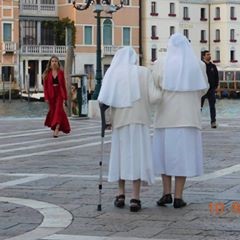Almost every week I stumble on a comment, post or reference to another 'treasure' in Italy. It may be a stunning work of art, museum or landscape but I also discover people with a dedication to their village, crafts or ancient skills.
Agnone is a town I have not visited and had to search online for the map location. Jenifer Landor shared some of the special people you can meet in Agnone.
The story of the bells..........
 |
| Photo credit: http://liveandlearnitalian.com/ |
Agnone is a town I have not visited and had to search online for the map location. Jenifer Landor shared some of the special people you can meet in Agnone.
 |
| Jenifer Landor |
The story of the bells..........
"The
fascinating heritage of a small Italian town in the Apennine hills - where, for centuries
the Marinelli family have been making bells"
"The 3rd
oldest
continuously family-owned business in the
world is in Molise – in the small town of Agnone, where my grandfather’s
cousins have been making bells for over 1000 years. A heritage passed down from
father to son in a town famous for its artisans – gold, silver, copper, stone
and ironwork among the most important."
"At
one time, there were 6 families making bells in Agnone – today, only the
Marinelli family continues the craft, sending bells all around the world."
"As
a child growing up in America, my mother used a small Marinelli bell to call us
to dinner – it could be heard throughout the neighbourhood. We dimly knew the
story, and acknowledged some pride in being related to the ‘oldest bell makers
in the world’. Our family visit to Agnone one summer left a deep and lasting
impression on all of us.
In the bell foundry as Children in the summer of 1967 –
In the bell foundry as Children in the summer of 1967 –
"But
it is really only now, having spent considerable time in this unique town, that
I begin to understand the enormity of this heritage."
"La Fonderia Pontificia Marinelli continues today to use the original ‘lost wax’ technique of
its founders. Artisans first imprint a wax form of the design onto a brick
structure covered in clay, which is then overlaid with a second layer of clay
to form a ‘false bell’. When the wax
inside is melted, it leaves the design imprint on the inside of the ‘false
bell’."
the art room where wax designs are being created
Using an ancient wood-burning furnace,
the molten bronze is heated to a temperature of 1200c (2200f) and poured into
the gap between to form the bell.
The Marinelli Bell Foundry after WWII
"The process of creating a bell in this
way, entirely by hand, takes a minimum of 3 months and requires enormous
strength, courage and concentration. The mould is placed in a deep pit where it
is buried in sand and soil which has been carefully patted down to prevent the
slightest movement. When molten bronze flows into the space between the ‘soul’
and the ‘false’ bells, a priest says a blessing and the workers come together
to offer prayers. As the bell begins to cool, good wishes are exchanged. Later
it is sanded and polished and the clapper is added to produce the correct
sound."
Take a look at the foundry - https://www.youtube.com/watch?v=n2lFmCReiP8
 |
| the Art room |
"In 1924 Pope Pius XI granted Papal
status to the foundry – hence, its official name, Pontificia Fonderia Marinelli. 30 years later, the Italian
President honoured the Marinelli Family with a gold medal for their prestigious
work and status as the oldest family business in Europe.
Some of the famous bells created at the Marinelli
Foundry are:
1923 Pompeii
–restoration of the Mariano Sanctuary
1950 Monte
Cassino - reconstruction of the Church of San Benedetto, destroyed during the
battle of Monte Cassino in WWII
1961 Rome
– commemoration of 100th anniversary of the founding of Italy
1992 Washington
DC – to commemorate 500th anniversary of Christopher Columbus’s
discovery of America
1995 NYC –
for the 50th Anniversary of the United Nations
2000 Rome
- Jubilee Bell for St Peter’s Square, inaugurated by John Paul II
2004 Pisa
- Leaning Tower, a 600k replica of the 17th century bell damaged in
the bombing of 1944"
"If you are thinking of an experience in a small town to learn Italian and meet the locals contact":
I hope Jenifer will share more about learning Italian with locals in a future post.
Meanwhile contact her directly.
I hope Jenifer will share more about learning Italian with locals in a future post.
Meanwhile contact her directly.
LIVE AND LEARN ITALIAN invites you to
combine Italian study with exploring the traditions and everyday life of the
region, mixing with the community and engaging in local activities. Of course,
a visit to the Foundry is high on the list of special events.
Live And Learn Italian
Intensive language and culture holidays - off the beaten track
+44 7771 750 189http://liveandlearnitalian.com/
Like our Facebook page






No comments:
Post a Comment
I am unable to respond to anonymous emails.
Include your contact information and comments in English please.
Note: Only a member of this blog may post a comment.